Roofing Companies Croydon
Top Roofers in Croydon
Get 3 FREE Roofing Service quotes for your project today! Compare profiles, reviews, accreditations, portfolio, etc... and choose the best deal.
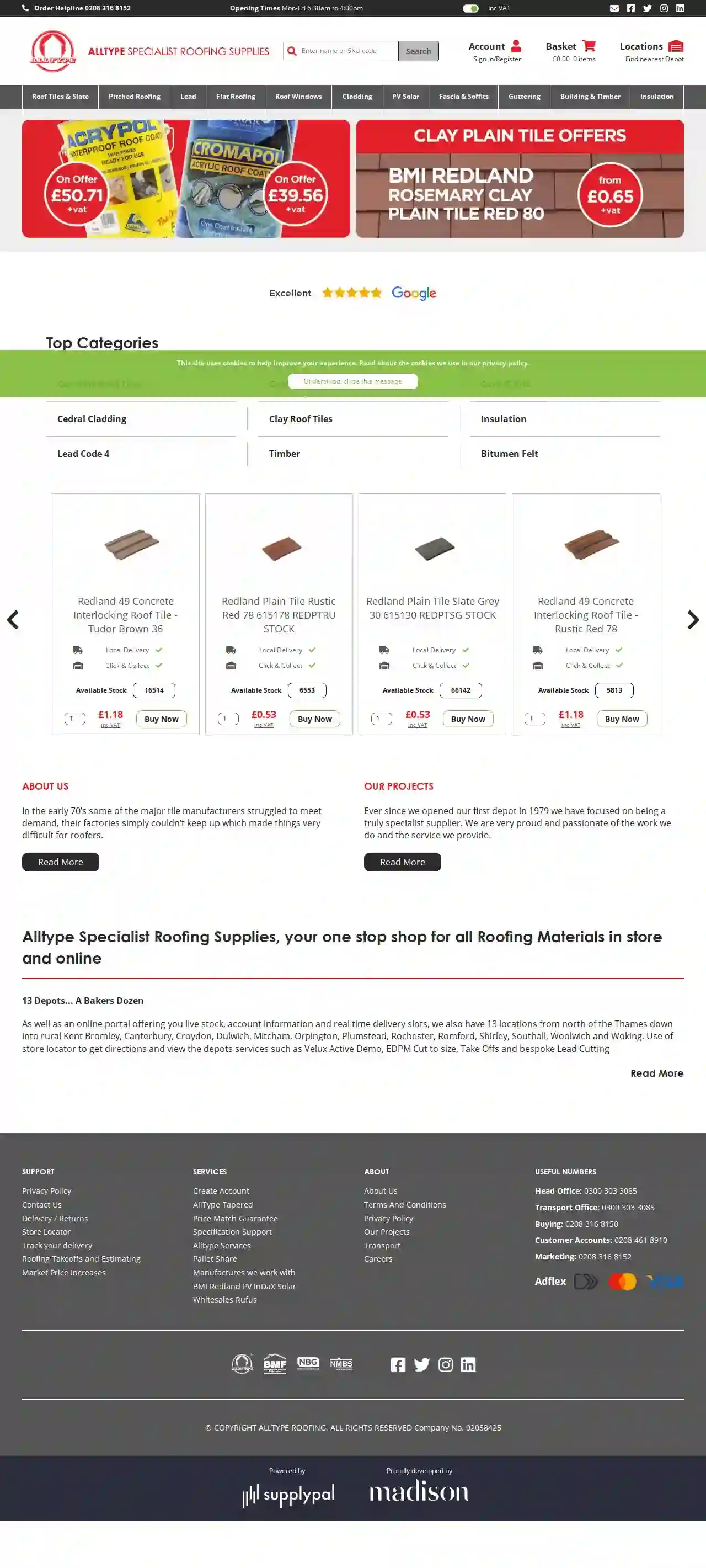
Alltype Roofing Shirley
4.412 reviewsUnknown, GBAllType Roofing is a leading supplier of roofing materials and solutions. With a wide range of products and services, we cater to the needs of both trade and DIY customers. Our extensive product portfolio includes roof tiles, slate, concrete roof tiles, clay roof tiles, pitched roofing, flat roofing, and more. We also offer a variety of accessories and fixings to ensure a seamless installation process. At AllType Roofing, we pride ourselves on providing excellent customer service, competitive pricing, and a commitment to quality. Whether you're a professional roofer or a DIY enthusiast, we have everything you need to complete your roofing project.
- Services
- Why Us?
- Accreditations
- Gallery
Get Quote
Homecare roofing services
3.33 reviewsCroydon, GBAccount Suspended This Account has been suspended. Contact your hosting provider for more information.
- Services
- Why Us?
Get Quote
G.S. Moore Roofing Contractors Ltd
3.97 reviewsCroydon, GBWe are G S Moore Roofing. A family based, expert roofing company with over 40 years experience. Experts in all aspects of roofing, we specialise in Unifold, EPDM Rubberbond, Slating, Tiling, Asbestos Removal, Asphalt, Felt, Liquids, Lead, Copper and roof carpentry. We are a proud, family roofing company established in 1983 based in Shirley, Croydon providing roofing works on both commercial and residential properties throughout London and the surrounding areas as well as all the Home Counties. Being a family run business, we strive to provide an elite, personal service for all clients, existing and new. We can provide a full technical roofing survey and report, by our qualified technical managers. Team GS Moore strive relentlessly each day to keep up with current legislation and modern day requirements and we are constantly researching and testing the latest products available to give our clients the best options available. We are approved fitters in many top quality roofing products and are RISQS and Chas approved also.
- Services
- Why Us?
- Our Team
- Gallery
Get Quote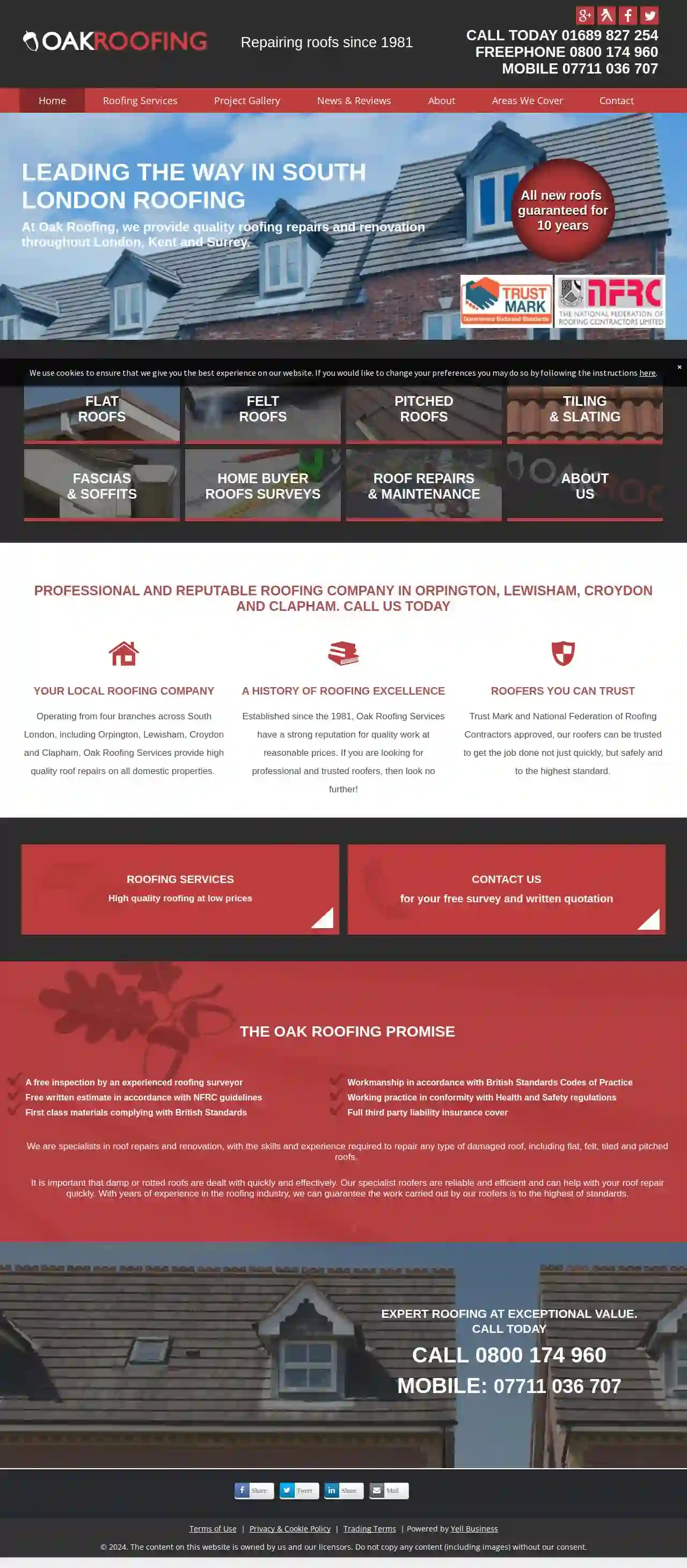
Oak Roofing Services
11 reviews21 St Thomas Drive, Orpington, BR5 1HE, GBRepairing roofs since 1970, Oak Roofing Services is a leading roofing company in South London, Kent, and Surrey. With a history of excellence, we provide high-quality roofing repairs and renovation services. Our team of experienced roofers is Trust Mark and National Federation of Roofing Contractors approved, ensuring that our work is done safely and to the highest standard. We have branches in Orpington, Lewisham, Croydon, and Clapham, and we work 6 days a week to ensure that your roof is repaired quickly and efficiently.
- Services
- Why Us?
- Accreditations
- Gallery
Get Quote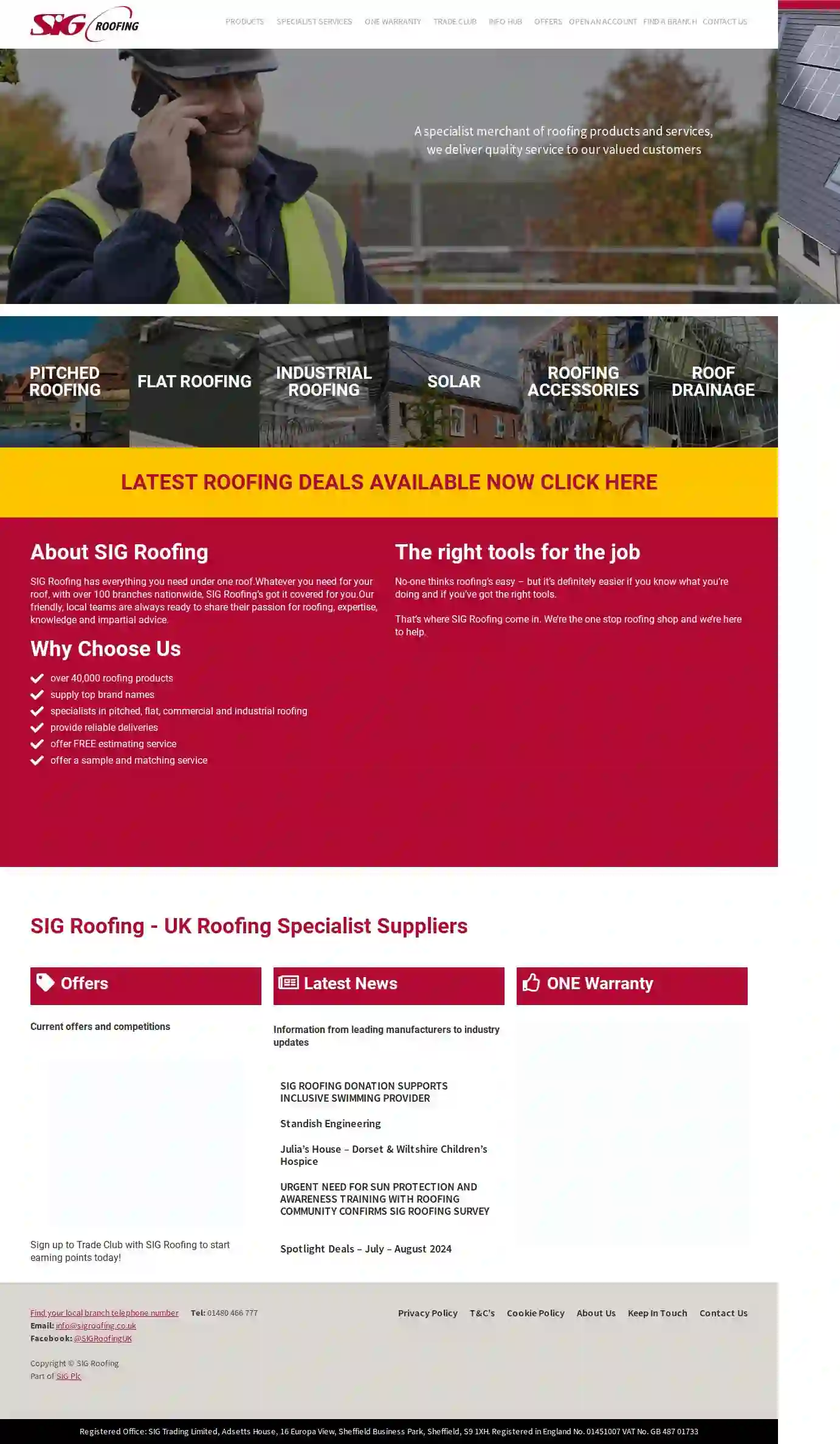
SIG Roofing Croydon Lansdowne
4.246 reviewsCroydon, GBSIG Roofing is a specialist merchant of roofing products and services, delivering quality service to our valued customers. Established for over 40 years – with branches throughout the UK from Inverness to Plymouth. We have everything you need under one roof. Whatever you need for your roof, with over 100 branches nationwide, SIG Roofing’s got it covered for you. Our friendly, local teams are always ready to share their passion for roofing, expertise, knowledge and impartial advice.
- Services
- Why Us?
- Gallery
Get Quote
SIG Roofing Croydon Beddington
4.513 reviewsNA, GBSIG Roofing is a specialist merchant of roofing products and services, delivering quality service to our valued customers. Established for over 40 years – with branches throughout the UK from Inverness to Plymouth. We have everything you need under one roof. Whatever you need for your roof, with over 100 branches nationwide, SIG Roofing’s got it covered for you. Our friendly, local teams are always ready to share their passion for roofing, expertise, knowledge and impartial advice.
- Services
- Why Us?
- Accreditations
- Our Team
- Testimonials
- Gallery
Get Quote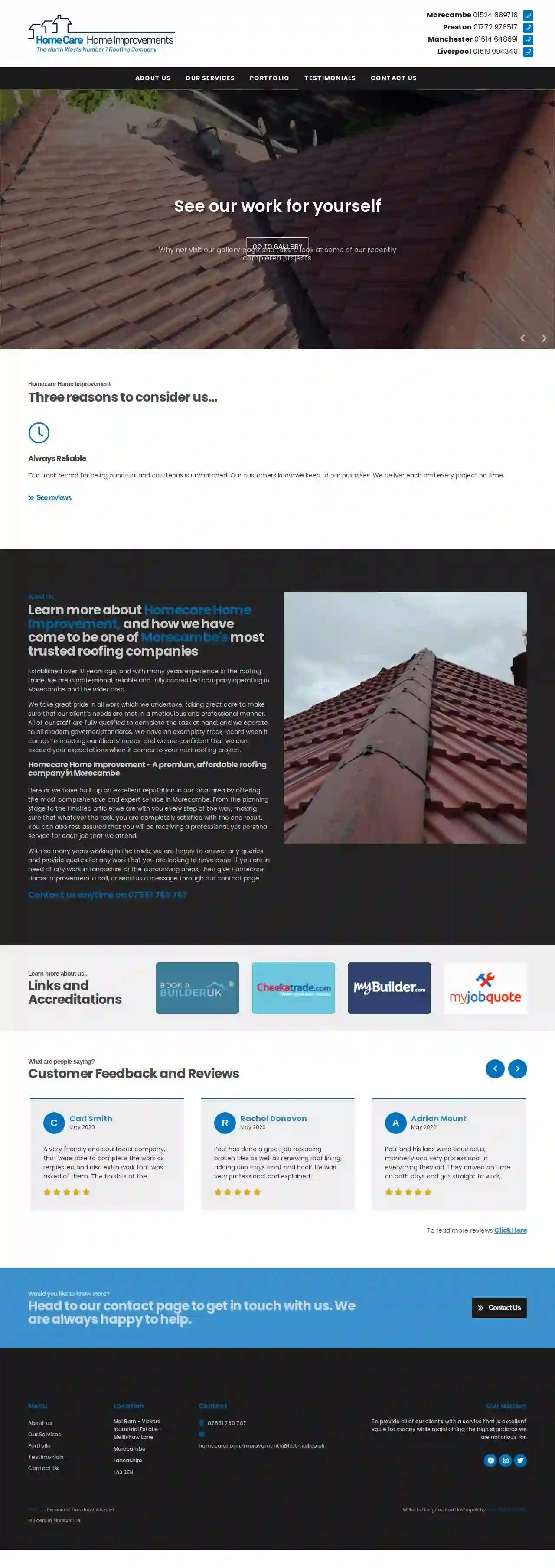
Homecare Home Improvements
4.84 reviewsMel Barn - Vickers Industrial Estate - Mellishaw Lane, Morecambe, LA3 3EN, GBHomecare Home Improvement is a Morecambe-based roofing company with over 10 years of experience in the trade. We are a professional, reliable, and fully accredited company operating in Morecambe and the wider area. We take great pride in all work undertaken, ensuring our clients' needs are met meticulously and professionally. Our staff are fully qualified to complete any task, adhering to modern governed standards. We have an exemplary track record of meeting client needs and are confident in exceeding expectations for your next roofing project. We offer a comprehensive and expert service in Morecambe, from planning to completion, ensuring complete customer satisfaction. We provide a professional yet personal service for every job.
- Services
- Why Us?
- Our Team
- Testimonials
- Gallery
Get Quote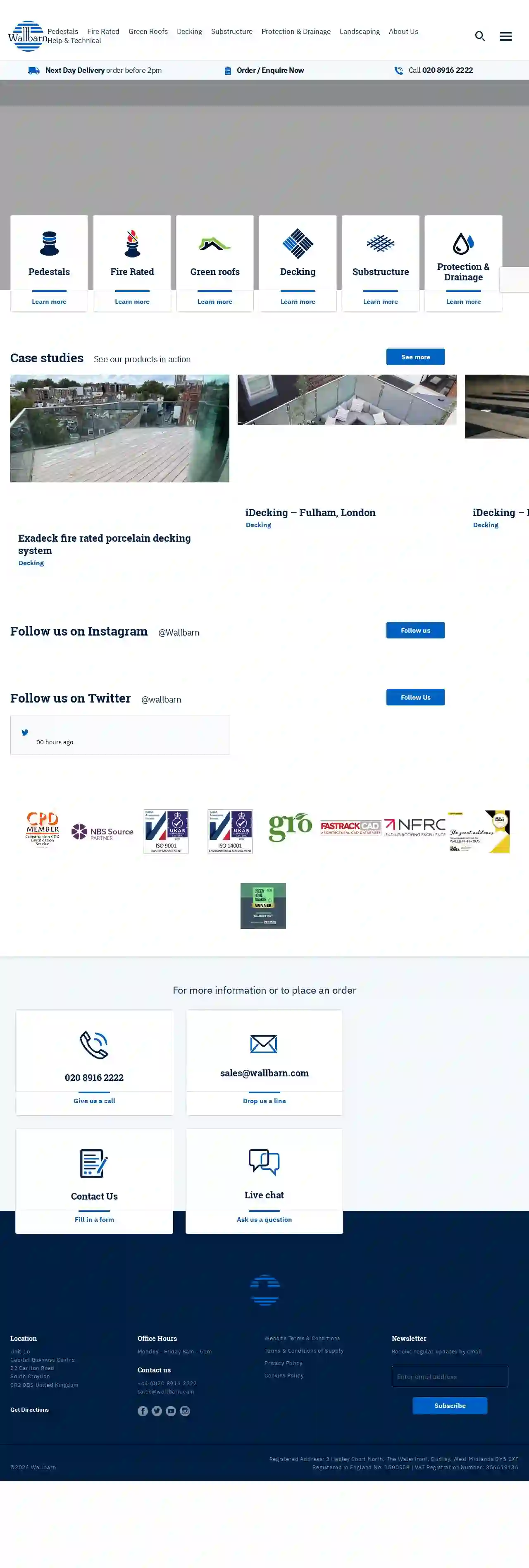
Wallbarn Ltd
4.856 reviews22 Carlton Road, Unit 16, Capital Business Centre, South Croydon, CR2 0BS, GBWallbarn is a leading supplier of innovative products for the construction industry, specializing in pedestals, fire-rated solutions, green roofs, decking, substructures, protection & drainage, and landscaping. With a commitment to quality and customer satisfaction, Wallbarn offers a wide range of high-performance products designed to meet the demands of modern construction projects. From easy installation and levelling on roofs and terraces to environmentally friendly solutions for open spaces, Wallbarn provides comprehensive solutions for a variety of applications. The company's extensive product portfolio includes adjustable pedestals, self-levelling heavy-duty pedestals, balance pedestals, megapad pedestals, fixed height pedestals, rail systems, and accessories. Wallbarn's fire-rated pedestals are certified to Class A1 and Class B1 standards, ensuring safety and compliance with building regulations. Wallbarn's green roof solutions offer sustainable and aesthetically pleasing options for flat roofs and podium decks. The company's decking solutions, including the exclusive iDecking system, provide durable and stylish surfaces for outdoor spaces. Wallbarn's substructure systems offer increased stability to paving, tiling, and decking, while its protection & drainage products safeguard surfaces from damage. Wallbarn's commitment to innovation and customer service has earned the company a reputation as a trusted partner in the construction industry. With a team of experienced professionals and a comprehensive range of products, Wallbarn is dedicated to providing solutions that meet the evolving needs of its clients.
- Services
- Why Us?
- Accreditations
- Our Team
- Testimonials
- Gallery
Get Quote
Premier Reclaimed Bricks
4.454 reviews150 Canterbury Road, Croydon, CR0 3HD, GBPremier Reclaimed Bricks, founded by Mr. Billy O'Brien in 1971, is a respected name in the reclaimed bricks industry. After years of dedication and hard work, Mr. O'Brien handed over the reins to his sons, Mark and Lee O'Brien, who continued to uphold the family legacy. The business had humble beginnings, with just one lorry clearing reclaimed bricks from demolition sites across Greater London. As the years passed, the business flourished, enabling Billy to acquire a dedicated depot for Premier Reclaimed Bricks, located on Canterbury Road in Croydon. This depot stands as our primary reclaimed brick hub, complete with a fleet of vehicles to meet the demands of our valued clients. With decades of experience under our belt, Premier Reclaimed Bricks has become a trusted partner for companies of all sizes, whether they are property developers or private owners. We are proud to supply high-quality reclaimed bricks to a wide range of clients, ensuring the success of their building projects in London and beyond.
- Services
- Why Us?
- Our Team
- Gallery
Get Quote
Eco Roofing
52 reviews7 Kingswood Way, CR2 8QL, GBEco Roofing are metal roofing specialists with over 20 years industry experience using zinc and copper materials across both residential and commercial projects. Based in Croydon, we cover London, Kent, Sussex, and Surrey, as well as specific schemes further afield. Get in touch with our team to discuss your requirements today. We offer a professional, reliable and trustworthy service. In 2002 we fitted the London Bridge Dome, winner of the John Smiths Copper Federation Award. Unlike mineral felt, it has a very long life span and comes with a 25 year guarantee. For more details, call our expert team today.
- Services
- Why Us?
- Our Team
- Gallery
Get Quote
Over 12,314+ Roofing Contractors onboarded
Our roofing pros operate in Croydon and surrounding areas!
Roofyng.co.uk has curated and vetted Top Roofers near Croydon. Find a top & trustworthy pro today.
Frequently Asked Questions About Roofing Companies
- Ventilation: Soffit vents provide intake ventilation, allowing fresh air to enter the attic and regulate temperature and moisture.
- Aesthetics: It creates a finished look to the roof's underside.
- Pest Control: A properly sealed soffit prevents pests like birds and squirrels from nesting in the attic.
- Style: Consider your home's architectural style and choose a roofing material that complements it.
- Climate: Factor in your local climate conditions. Some materials perform better in extreme heat, cold, or high winds than others.
- Budget: Roofing materials have a wide range of costs. Determine your budget and choose materials that fit your financial constraints.
- Durability and Lifespan: Assess the expected lifespan and durability of different materials.
- Energy Efficiency: Choose materials with good insulation and reflectivity properties to improve your home's energy efficiency.
- Safety First: Avoid going onto the roof during a storm, as it's dangerous.
- Document the Damage: Take photos and videos of the damage for insurance purposes.
- Contact Your Insurance Company: Report the damage to your insurance company as soon as possible to initiate a claim.
- Temporary Repairs: If safe, address any immediate leaks using buckets or tarps to minimize further damage.
- Contact a Roofing Contractor: After the storm, have a qualified roofing contractor inspect the roof and provide a repair estimate.
- Choose Reflective Roofing Materials: Opt for light-colored shingles or metal roofing that reflects sunlight and reduces heat absorption.
- Install Proper Attic Insulation: Adequate insulation prevents heat loss in the winter and heat gain in the summer.
- Ensure Adequate Ventilation: Proper attic ventilation allows hot air to escape, reducing cooling costs and extending the lifespan of your roof.
- Consider a Radiant Barrier: In hot climates, a radiant barrier installed in the attic can reflect heat away from the roof, further reducing cooling needs.
What is a soffit, and why is it important for my roof?
How do I choose the right roofing materials for my home?
What should I do if my roof is damaged in a storm?
How can I make my new roof more energy-efficient?
What is a soffit, and why is it important for my roof?
- Ventilation: Soffit vents provide intake ventilation, allowing fresh air to enter the attic and regulate temperature and moisture.
- Aesthetics: It creates a finished look to the roof's underside.
- Pest Control: A properly sealed soffit prevents pests like birds and squirrels from nesting in the attic.
How do I choose the right roofing materials for my home?
- Style: Consider your home's architectural style and choose a roofing material that complements it.
- Climate: Factor in your local climate conditions. Some materials perform better in extreme heat, cold, or high winds than others.
- Budget: Roofing materials have a wide range of costs. Determine your budget and choose materials that fit your financial constraints.
- Durability and Lifespan: Assess the expected lifespan and durability of different materials.
- Energy Efficiency: Choose materials with good insulation and reflectivity properties to improve your home's energy efficiency.
What should I do if my roof is damaged in a storm?
- Safety First: Avoid going onto the roof during a storm, as it's dangerous.
- Document the Damage: Take photos and videos of the damage for insurance purposes.
- Contact Your Insurance Company: Report the damage to your insurance company as soon as possible to initiate a claim.
- Temporary Repairs: If safe, address any immediate leaks using buckets or tarps to minimize further damage.
- Contact a Roofing Contractor: After the storm, have a qualified roofing contractor inspect the roof and provide a repair estimate.
How can I make my new roof more energy-efficient?
- Choose Reflective Roofing Materials: Opt for light-colored shingles or metal roofing that reflects sunlight and reduces heat absorption.
- Install Proper Attic Insulation: Adequate insulation prevents heat loss in the winter and heat gain in the summer.
- Ensure Adequate Ventilation: Proper attic ventilation allows hot air to escape, reducing cooling costs and extending the lifespan of your roof.
- Consider a Radiant Barrier: In hot climates, a radiant barrier installed in the attic can reflect heat away from the roof, further reducing cooling needs.